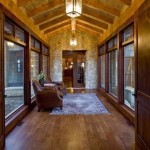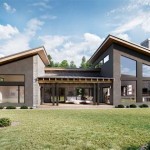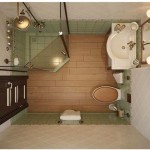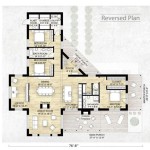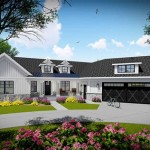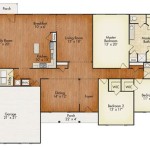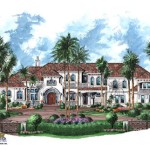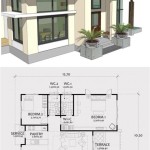Frank Lloyd Wright Inspired House Plans: Embracing Organic Architecture
Frank Lloyd Wright, an iconic figure in American architecture, left an indelible mark on residential design. His philosophy of organic architecture, emphasizing harmony between human habitation and the natural world, continues to inspire homeowners and architects alike. Wright's designs prioritize horizontal lines, open floor plans, natural materials, and abundant natural light, creating spaces that are both aesthetically pleasing and functionally efficient. For those seeking to imbue their homes with this timeless aesthetic, understanding the key principles of Wright's style is crucial to successfully implementing Frank Lloyd Wright inspired house plans.
The pursuit of a Frank Lloyd Wright-inspired home involves more than simply replicating surface features. It is about embracing the underlying principles that guided his design philosophy. Attention to detail, a deep understanding of material properties, and a dedication to creating spaces that enhance the lives of their occupants are all hallmarks of this architectural style. This article delves into the defining characteristics of Frank Lloyd Wright's architectural vision and provides insights into how these principles can be applied to contemporary house plans.
Key Principles: Organic Architecture
At the heart of Frank Lloyd Wright's design philosophy lies the concept of organic architecture, a belief that buildings should grow naturally from their site, reflecting the surrounding landscape and integrating harmoniously with it. This extends beyond mere aesthetics; it encompasses the entire approach to design, from the initial site selection to the final selection of interior furnishings.
One of the most prominent features of organic architecture is the emphasis on horizontal lines. Wright believed that these lines echoed the natural contours of the land and created a sense of stability and grounding. Long, low-pitched roofs, cantilevered overhangs, and continuous bands of windows are all common elements used to emphasize horizontality. These features not only contribute to the visual appeal of the structure but also serve practical purposes, such as providing shade and protecting the building from the elements.
The use of natural materials is another cornerstone of organic architecture. Wright favored materials such as wood, stone, and brick, sourced whenever possible from local quarries and forests. These materials were often left in their natural state, revealing their inherent textures and colors. By using materials that were already present on the site, Wright sought to create a seamless transition between the building and its surroundings.
Integration with the site is paramount. Wright meticulously considered the topography, climate, and vegetation of each site before commencing design. He often incorporated natural features, such as existing trees and rock formations, into the building's design. The use of large windows and skylights maximized natural light and provided expansive views of the surrounding landscape, further blurring the lines between indoors and outdoors.
Finally, organic architecture emphasizes the interconnectedness of all elements within a building. From the layout of the rooms to the selection of furniture, every detail is carefully considered to create a cohesive and harmonious whole. Wright often designed custom furniture and lighting fixtures to complement the architecture of his buildings, ensuring that every element contributed to the overall aesthetic and functionality of the space.
Incorporating Open Floor Plans and Natural Light
Frank Lloyd Wright was a pioneer in the development of open floor plans, a design concept that revolutionized residential architecture. By eliminating interior walls and creating flowing spaces, Wright aimed to foster a sense of connection and community within the home. Open floor plans also allowed for greater flexibility in the use of space, adapting to the changing needs of the occupants over time.
Wright recognized the importance of natural light in creating healthy and vibrant living spaces. He strategically placed windows and skylights to maximize the amount of daylight entering the building, reducing the need for artificial lighting and creating a more cheerful and welcoming atmosphere. The use of clerestory windows, placed high on the walls, allowed light to penetrate deep into the interior, illuminating even the most secluded corners of the house.
Careful consideration was given to the orientation of the building in relation to the sun. Wright often positioned his homes to take advantage of passive solar heating in the winter and to minimize heat gain in the summer. Overhangs and deep eaves provided shade during the hottest months, while allowing sunlight to penetrate during the colder months. This passive solar design not only reduced energy consumption but also created a more comfortable and sustainable living environment.
The integration of indoor and outdoor spaces was another key aspect of Wright's approach to natural light. Large windows and sliding glass doors connected the interior of the home to patios, decks, and gardens, creating a seamless transition between indoors and outdoors. This allowed natural light to flow freely throughout the home, blurring the boundaries between the built environment and the natural world.
Modern Frank Lloyd Wright inspired house plans often incorporate sustainable design principles, further enhancing the benefits of natural light. Energy-efficient windows and skylights, combined with light-colored interior finishes, maximize the reflection and distribution of natural light, reducing the need for artificial lighting and lowering energy bills.
Implementing Frank Lloyd Wright Inspired Details in Modern Designs
While a full-scale replication of a Frank Lloyd Wright home may not be feasible or desirable for all homeowners, incorporating specific details and design elements can be a practical way to infuse a modern home with the spirit of Wright's architecture. Thoughtful selection of materials, careful attention to detail, and a deep understanding of Wright's design principles are essential for achieving a successful and authentic result.
The use of natural materials is a fundamental aspect of Wright's style that can be easily incorporated into modern designs. Wood, stone, and brick can be used for exterior cladding, interior walls, and flooring. Using these materials in their natural state, revealing their inherent textures and colors, can add warmth and character to a space. Consider incorporating exposed wood beams, stone fireplaces, or brick accent walls to create a rustic and inviting atmosphere.
Horizontal lines can be emphasized through careful design choices. Low-pitched roofs, long, narrow windows, and horizontal siding can all contribute to a sense of stability and grounding. Consider incorporating cantilevered elements, such as balconies or overhangs, to further enhance the horizontal aesthetic. These features not only add visual interest but also provide practical benefits, such as shading and weather protection.
Incorporating built-in furniture and millwork is another hallmark of Wright's style. Built-in shelves, cabinets, and seating can create a seamless and integrated look, maximizing space and minimizing clutter. Consider designing custom furniture pieces that complement the architecture of the home, echoing the horizontal lines and incorporating natural materials. Wright often designed his own furniture, believing that it should be an integral part of the overall design.
Pay attention to the details. Wright was meticulous in his attention to detail, believing that every element of a building should contribute to the overall design. Consider incorporating geometric patterns, stained glass windows, and unique lighting fixtures to add visual interest and character. Wright often used geometric motifs inspired by nature, such as squares, triangles, and circles. These patterns can be incorporated into windows, doors, and other architectural details.
Finally, consider the landscaping. A well-designed landscape can enhance the organic quality of the home and create a seamless transition between indoors and outdoors. Use native plants and natural materials, such as stone and wood, to create a landscape that complements the architecture of the home. Consider incorporating water features, such as ponds or fountains, to add a sense of tranquility and serenity.
By carefully considering these details and design elements, homeowners can successfully incorporate the spirit of Frank Lloyd Wright's architecture into their modern homes, creating spaces that are both aesthetically pleasing and functionally efficient, embodying the timeless principles of organic architecture.

Frank Lloyd Wright Inspiration 20092ga Architectural Designs House Plans

Frank Lloyd Wright Inspired Home Plan 85003ms Architectural Designs House Plans

5 Great Architectural Inspirations From Frank Lloyd Wright The House Designers

Frank Lloyd Wright Inspired Homes For Modern Living Loyd Houses

New Frank Lloyd Wright Inspired Homes Based On Usonian Designs Foundation

Frank Lloyd Wright Inspiration Contemporary Rambler Home Plan 501 By Tjb Homes

Frank Lloyd Wright Inspired Home Plan 85003ms Architectural Designs House Plans

Three Frank Lloyd Wright Unbuilt Houses Brought To Life As Digital Reconstructions

Wisconsin Modern Frank Lloyd Wright Inspired Home Leverage

Renovation Of Frank Lloyd Wright Prairie Style Villa Into A Hotel Kamiya Architects Archdaily

